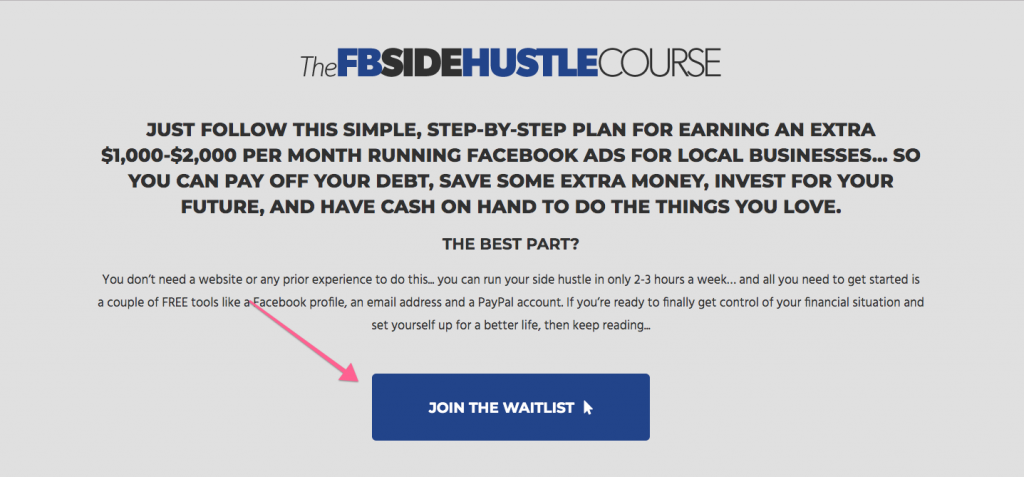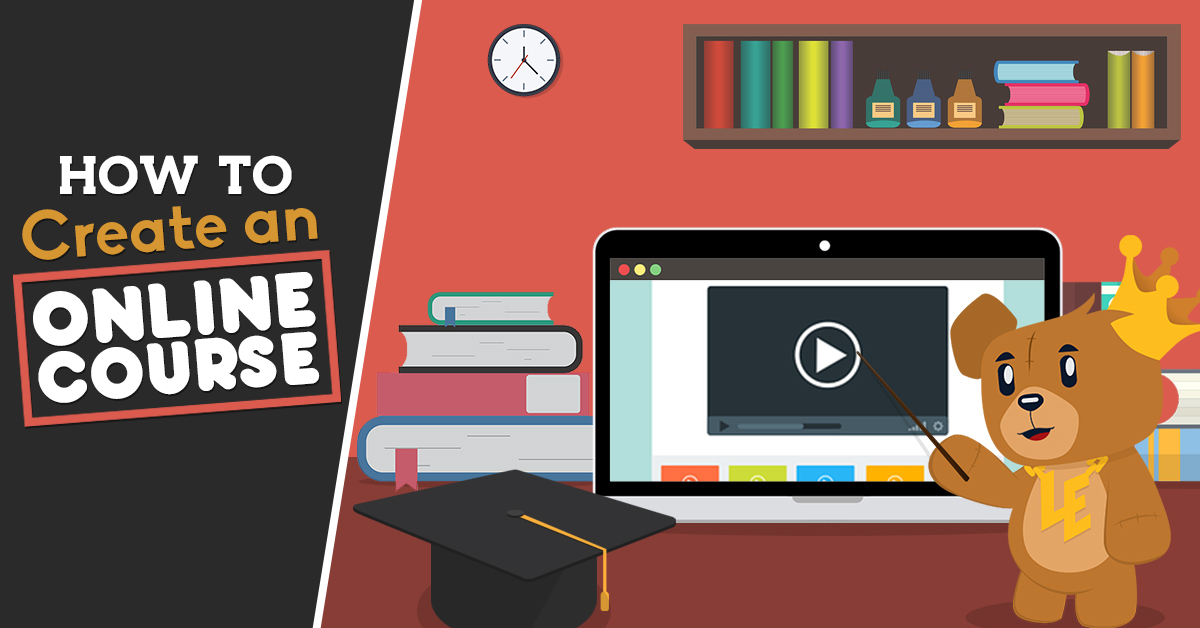Learning how to create an online course is one of the best business decisions we’ve made in the past couple of years. Our Facebook Side Hustle Course has helped tons of people start making more money to pay off debt, leave their day jobs, and save for retirement.
… and it’s also helped us make a lot of money.
We’d be lying if we didn’t bring that up, and it’s why learning how to create an online course is something that a lot of bloggers, freelancers, and solopreneurs are thinking about these days.
To help you get started, we’re going to give you the complete guide to learning how to create an online course.
We’ve broken it down into nine easy to follow steps, starting with how to choose a marketable topic to price your course, and more. And because we love bonus content when it comes to online courses, we’ll tell you about our favorite type of course bonus and why you need to add it to your course.
Keep reading to learn how to create an online course!
Step 1: Choose a topic
Learning how to create an online course starts with a basic step — deciding what you’re going to teach. Your online course should be focused on something you know a lot about, something you’re passionate about, and be a profitable topic.
Those are the guidelines for choosing a course topic, but let’s break them down a little more:
- Things you know a lot about. Are you an expert on a specific topic? Do you have specialized training or a degree in something? What do you have practical or working knowledge of? What do people ask you questions about?
- Your passion. Is there something you love doing? Do you feel like you have a calling? Passion motivates people, and infusing your course with your passion can go a long way in both teaching and selling.
- People are willing to pay for solutions to their problems, so find a problem and help people solve it.
Want an example?
The Minimalist Baker is a blog dedicated to quick and easy vegan recipes, and they offer a course called Food Photography School. The topic of the course is to teach people how to take beautiful photos of food.
As a food blogger with seven years of experience, the Dana Shultz of the Minimalist Baker has both a lot of knowledge and passion for food photography (sometimes these things are intertwined). And the course answers a question that other food bloggers and influencers ask — how do I take amazing photos of food?
And, realizing that many bloggers and social media influencers might not have expensive camera equipment, the Shultz went a step further to offer an additional or add-on course that answers this question — how do I take amazing photos of food with my phone?
High-quality photos go a long way on social media and Pinterest, and they can drive traffic to your site. That increases your earning potential. Because what the course teaches can help others earn more money, it’s a profitable course that can easily be seen as a business investment.
Make sense?
Learn more at: Choosing aTopic for Your Online Course
Step 2: Test your idea
Got your idea? Awesome!
Even though you’ve thought about how profitable it is, how do you know it’s really going to sell? Wouldn’t it be nice if there was an easy way to test your idea before you do all of the work of learning how to create an online course?
Good news… there is!
Actually, there are a few different ways to test your idea:
- Create a free mini version of your course
- Start a waiting list
- Pre-sell your course
There are reasons behind each of these, so let’s dig in…
Create a free, mini version of your course
A miniature version of your course is just going to touch on the subjects you want to cover in your full course. It should be enough to drive interest while offering value to your students. And a mini-version doesn’t have to include videos, worksheets, or any bonuses — it can be purely text-based and sent out via email.
A lot of good can come with a free product:
- You can capture email addresses to build your list when you’re ready for a full course launch.
- You get feedback on what people want to learn more about, what didn’t go well, etc.
- You have the time and space to work out all of the kinks.
If you decide to go this route, make sure you are providing real value. If you don’t, you run the risk of losing potential sales down the road.
Start a waiting list
This is what we’ve done for our Facebook Side Hustle Course and Facebook Ads for Bloggers. We did it because we knew there was a high need for both of those skills — we had around 900 people signed up for the waiting list for FBSH before the first launch.
To create a waiting list, you’ll need a landing page somewhere on your website. It should explain the problem and how you’re going to fix it. This page should generate desire, interest, and intrigue. Then give them a CTA — “Join the waiting list.”

While this is possibly the easiest way to learn how to create an online course and start testing it, you’re not gaining any insights. You’ve only tested to see whether or not the idea is marketable. And the reality is that not everyone on your waiting list is going to buy your online course.
On the plus side, you will have grown your email list.
Pre-sell your course
Yep, we’re talking about selling your course before you create it. And right now, you’re thinking, “Why would people buy something I haven’t even made?”
Well, it’s not as simplistic as asking people for money and then one day giving them some content. When we say “pre-sell,” we’re talking about pre-selling access to live training sessions that you drip out over the course of several weeks.
When you pre-sell a course, you cover all of the content you want to include and break it down into weekly training sessions — they can feel a little like coaching sessions. Hosting your course in a private Facebook group works really well because you can use it for live training videos, answers questions in real-time, and your students can interact with one another.
After your live course wraps up, you can take everything you learned, like what worked and didn’t, and fine-tune the course before your big launch. You’re also going to get some valuable testimonials that show social proof of what you’re teaching, which can be used on your sales page.
But what if I don’t generate enough interest to run the live course?
If you’re pre-selling, the fear is what happens if there isn’t enough interest to justify running the course. There’s an easy answer: refund their money.
But, go a little further and offer them a thank you for taking a chance on you. You can give them a free training session, access to a free webinar, a coupon, etc. Be honest about why you had to cancel and say, “Thanks for your support.”
No matter which test you choose, each of these strategies will either validate your course idea or not. This is something you want to learn before learning the rest of the steps on how to create an online course.
Step 3: Create an outline for your course
When you create an outline for your course, think about how you can break your topic down into digestible pieces of information — these will be your modules.
Here’s an easy way to think about what should be in each module:
- What I’m going to teach you
- What you need to learn
- What happens if you don’t
- How to do it
- Action item — tell your student to do something
If you’re teaching a video course, which we highly recommend, you should be able to cover everything on that list in around 10-15 minutes per module. Keep that in mind and break up topics that will take longer than 20 minutes to cover. Anything longer than that and your students will start losing interest.
Step 4: Create your course content
You’re at the part in learning how to create an online course where you really can get into a good flow. This can be a lot of fun, but before going on, you want to think about what type of media you’re going to use.
The majority of courses out there are videos, and there’s a good reason for that. You get a lot more personality with video. Your students can hear your voice, see your face (if you want), and our favorite, get a behind-the-shoulder view of what you’re teaching them.
That isn’t to say that text-based courses don’t sell. Our good friend Michelle Schroeder-Gardner of Making Sense of Cents has a wildly successful text-based course on affiliate marketing — Making Sense of Affiliate Marketing — that made over $400,000 in one year.
A combination of video and worksheets is a good fit for most courses. Worksheets should always be PDFs so your students can easily download and print them. They can be checklists, planners, etc. For videos, we highly recommend Loom. It’s great for recording quality screen share videos, and it’s what we use for our courses.
As you learn how to create an online course, remember that done is better than perfect. You can spend a lot of time and energy picking apart every single aspect of your course, but this can prevent you from ever launching.
Get your course out there and polish it later.
Step 5: Get your course online
There are a few online platforms for teaching, but our favorite is Teachable. There are currently over 68,000 online course creators using Teachable, earning over $338 million.
Teachable has three different pricing tiers, all of which let you teach an unlimited number of students, have instant payouts, integrated email marketing, product support, and more.
Here are some examples of Teachable courses:

Step 6: Price your course
There is a lot of fear and uncertainty that goes into pricing your course, but it doesn’t have to be stressful or complicated.
Before we dig into actual pricing, let’s talk about some of the most common hang-ups that come with pricing your course…
People can find this information on their own.
You’re right. They can. But you’re giving them a shortcut, and that’s the point.
They don’t have to go out and find the information — you’ve done that work for them. You’re probably giving them some gated insider knowledge that takes lots of experience to learn. That alone has more value than most things on the web.
Someone is selling a similar course for less money.
I bet they are, and they’re probably undervaluing their knowledge. Or, they know they haven’t put as much as they could into their course. Don’t be that person. You deserve to be paid fairly for what you’ve put into your course.
I don’t feel like an expert.
You need to know what you’re talking about, but you don’t have to be an expert to teach and sell an online course. It can be surprisingly helpful when a teacher is just a few steps ahead of their students because the problems and solutions are still fresh.
I don’t think people are willing to pay $X for a course.
There are going to be people who won’t pay $5 for a course, but that’s not who you’re trying to sell your course to. People value education, and if you’ve been emailing your list and warming them up for a few months, a number of them will be ready be willing to pay a fair price for your course.
Now to that actual pricing…
There are a lot of factors that go into pricing, so let’s use our Facebook Side Hustle Course to talk about some of them. This course teaches students how to do digital marketing on Facebook, and it’s hard to find a comprehensive course that covers that topic for less than $2000.
Our course first launched for $247.
Why such a low price, especially after what you read at the start of this section?
A big part of our audience came from Bobby’s site Millennial Money Man, which focuses on helping real people make more money to pay down debt and save for the future. We wanted this course to help those people, and pricing the course for too high wouldn’t connect well with how Bobby is helping people.
$247 was more than Bobby originally wanted to charge, but then we thought about the ROI. When our students landed just one client, the course will have paid for itself. We’ve since raised the price to reflect more additional work that’s been put into the course and the current valuation of the skill our students learning.
Here’s what you need to take away from that example:
- Think about your audience
- Think about your brand
- Think about the ROI
- It’s okay to raise the cost over time
For more on pricing, listen to How to Set Prices for Your Products. It’s full of valuable nuggets that will help you learn how to create an online course that sells, including:
- Low ticket vs. high ticket items
- Tying the price of your products to your experience
- When to give a discount
- How to be comfortable and confident in your pricing
- The value of protecting your success rate and reputation of your product
And much more.
Step 7: Launch your course
Launching your course starts months before the course even goes up for sale. You should be building up your email list and generating interest via your list and social media.
But once you’re ready to launch should you go evergreen or open-close enrollment?
Because an evergreen course is always for sale, it may bring in more consistent income, and your launch is less stressful. But, you have to consistently promote your course and miss out on the scarcity tactic.
Open-close enrollment creates a sense of urgency and excitement, and you also get to take a minute to process and tweak your sales strategy before your next launch. The downside is that there is a lot of stress at launch time and still lots of work between launches.
The reality is that both strategies make money, and here are a few more articles to help you launch your online course:
- The Beginner’s Guide to Creating a Sales Funnel
- Clickfunnels vs. Leadpages: How Do They Compare?
- How to Create an Online Course and Sell It
- Handling Objections During a Course Launch
Bonus Step: Create a Facebook community for your students
As you read through this article about how to create an online course, you’ve learned to always give your students value. The more value you provide, the more you can really help people. Offering your students access to a private Facebook group is one of the best ways to do that.
A private group does take more work to manage, so we advise that you give students one month of free access, and charge for additional months. This gives you a higher earning potential, but there is a lot of good that comes when you put all of your students together in a social setting.
Here are some of the perks of adding a private group component to your online course:
- Answering your students’ questions in a social setting helps others who might have the same question.
- More experienced students can help newbies.
- When you encourage members to share their wisdom, you get a diverse set of opinions and experiences.
- Students can share their successes and failures with people who know exactly what they’re going through.
You will need to set the tone (think no fighting, politics, religion, etc.). And you’ll also need to engage your students, which you can see in this weekly post in your group:

A private group is more work, but it’s legitimately one of our favorite parts of running our Facebook Side Hustle Course.
The final word on how to create an online course
There’s a lot of good that can come out of creating an online course, for both you and your students. So if you’ve ever had an idea for a course and/or the drive to make money by helping others, today is the day to get to work.


Leave a Reply